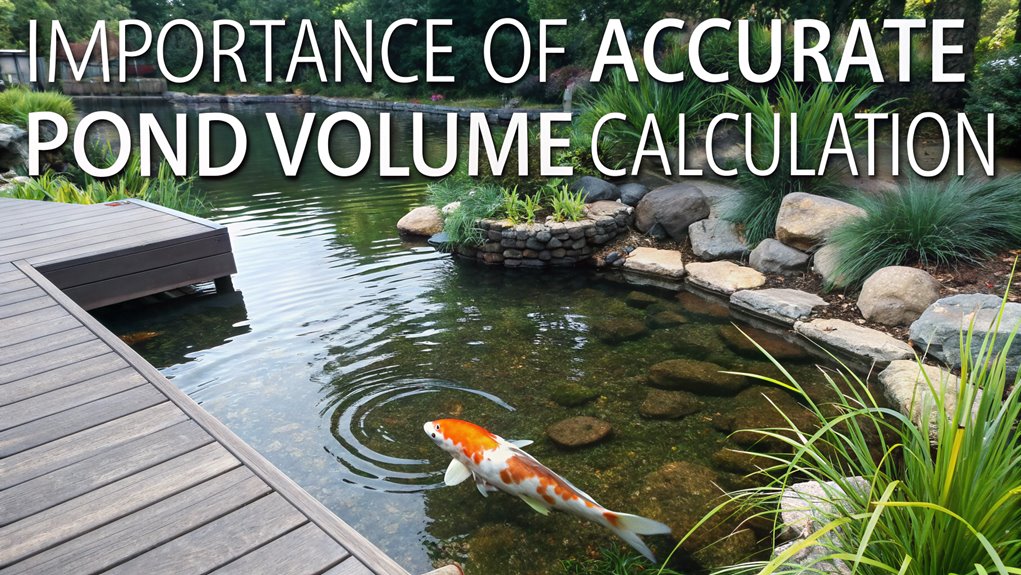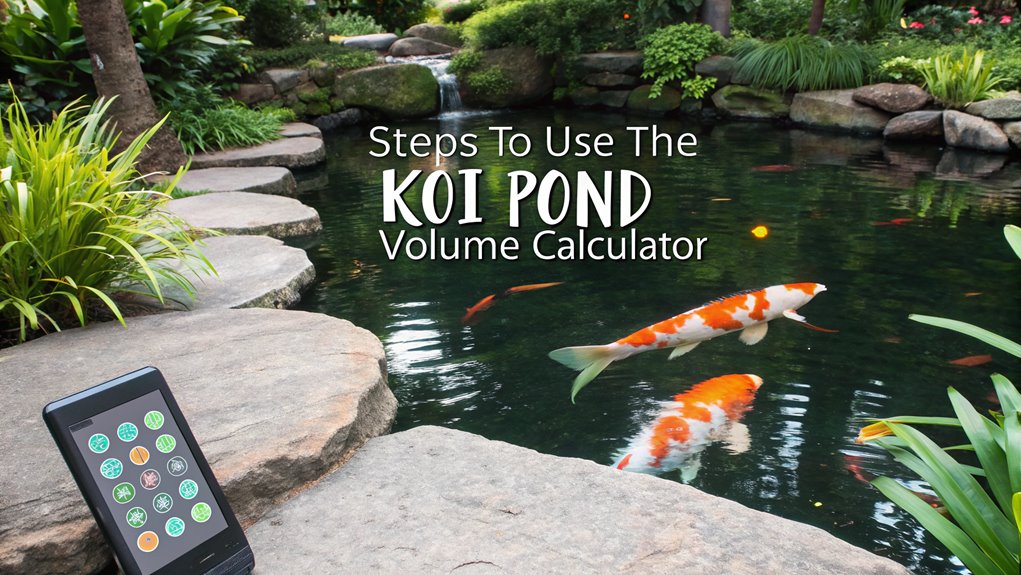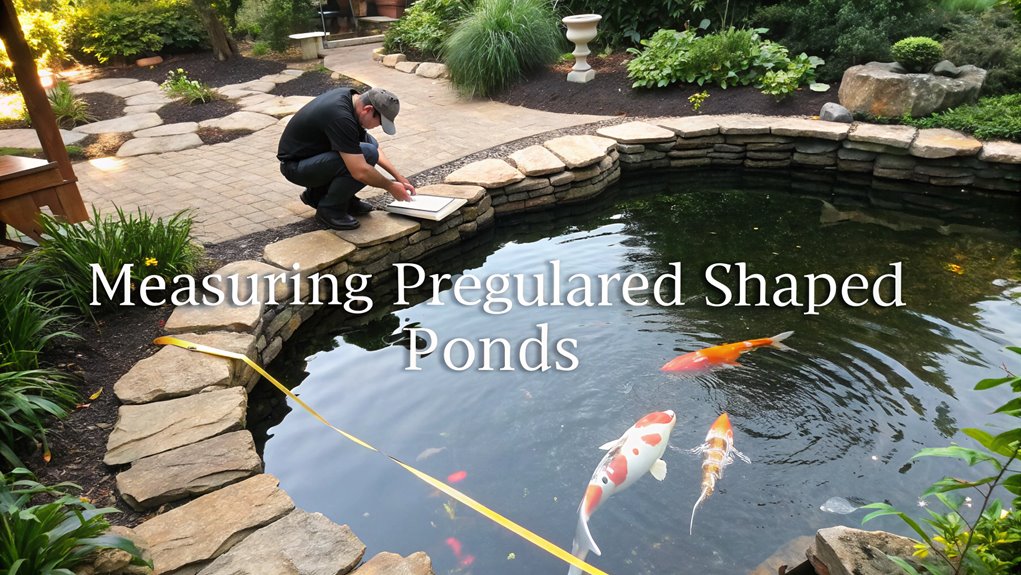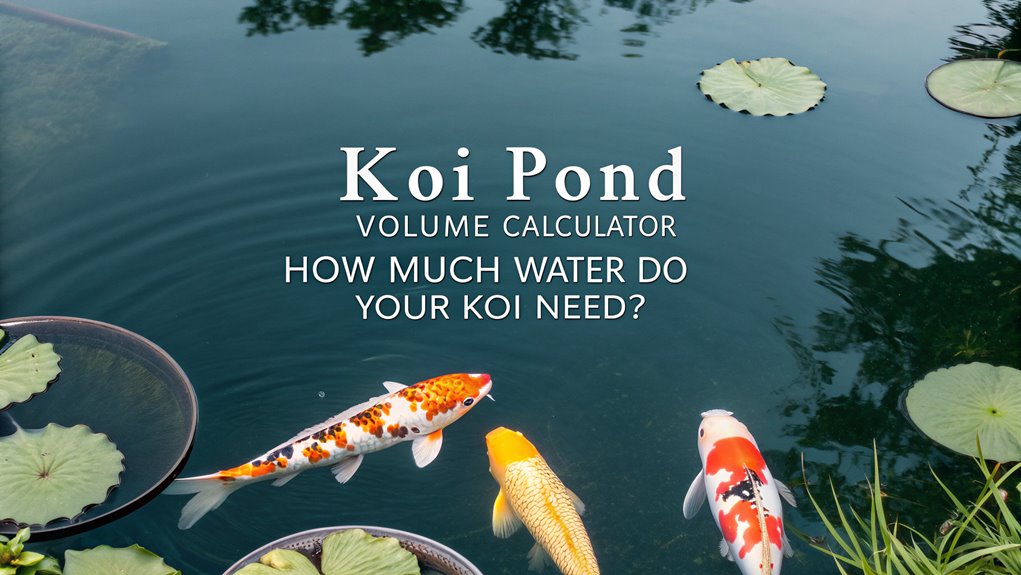Use a Koi Pond Volume Calculator to determine the precise amount of water your koi need. Measure the pond’s length, width, and average depth for rectangular ponds, or diameter and depth for circular ones. Maintain consistent measuring units to ensure accuracy. Calculate the volume in litres and imperial gallons for correct water treatments, pump, and filter choices. Accurate calculations are crucial for a healthy aquatic ecosystem, benefiting your koi’s health. Exploring the best methods can yield even better results.
Key Facts Summarized
- Measure pond dimensions accurately and input into a koi pond volume calculator for precise water needs.
- Ensure measurement units are consistent to avoid errors in volume calculation.
- Use the salt method for more accurate volume measurement, especially in irregularly shaped ponds.
- Choose a pump with a capacity of 50% more than the minimum required circulation for efficient water flow.
- Accurate pond volume ensures proper medication dosage and optimal water quality for koi health.
Importance of Accurate Pond Volume Calculation

Calculating your pond’s volume accurately is vital for maintaining a healthy aquatic environment. Knowing the precise pond volume ensures that you administer the correct dosage of medications and treatments, crucial for the health of your koi and goldfish.
An incorrect volume calculation can lead to under-dosing, compromising treatment efficacy, or overdosing, which could harm or even kill your fish. Furthermore, understanding your pond’s volume is essential when selecting pumps and filters, as these components have maximum volume ratings.
Proper volume measurement is key to maintaining optimal water quality, directly influencing the pond ecosystem’s health. Accurate calculations support effective maintenance planning and the selection of suitable water features, enhancing both the aesthetic and functional aspects of your pond. Additionally, monitoring ammonia levels is crucial to prevent toxicity and ensure the overall well-being of your koi.
Steps to Use the Koi Pond Volume Calculator

Understanding your pond’s volume is a cornerstone of effective pond management.
Begin by accurately measuring your water garden. For a rectangular pond, measure the length, width, and average depth. If your pond is circular, measure the diameter and depth.
Ensure all measurements are in either meters or feet, maintaining consistency for precise calculations. Input these figures into the Koi Pond Volume Calculator.
With a single click on the calculate button, derive the pond volume in litres and imperial gallons. This data is crucial for maintaining optimal water conditions and fish health. Additionally, knowing your pond volume aids in performing water quality checks to ensure a balanced ecosystem.
Accurate pond volume ensures precise chemical treatments and supports the ecological balance within your water garden.
For manual measurement techniques, refer to the detailed blog post.
Measuring Irregularly Shaped Ponds

When dealing with irregularly shaped ponds, obtaining an accurate volume measurement can be a bit more complex but is essential for effective pond management.
Begin with a rough estimate of your pond volume to set the stage for precise calculations. Measure the pond’s length, width, and average depth. Multiply these dimensions to get a cubic measurement. Divide by various factors considering the pond’s shape to refine your estimate. This step provides a baseline for further analysis.
Transition into the salt method by preparing to apply a specific amount of salt based on this rough estimate. Aim for a 3 parts per thousand (ppt) salt concentration.
After waiting 12-24 hours, measure salinity again. Utilize a specialized calculator to input these salinity changes, revealing the precise pond volume. Additionally, ensure that the balanced ecosystem is maintained, as this is crucial for the health of your Koi.
Salt Method for Precise Volume Measurement
For precise measurement of your koi pond’s volume, the salt method offers a reliable technique.
Begin by estimating the pond volume and adding enough salt to achieve a 3 parts per thousand (ppt) concentration, ideal for koi.
After 12-24 hours, use a salinity meter to record the final salinity level. This interval allows thorough mixing, crucial for accurate readings.
Input initial and final salinity values into a calculator to determine the pond’s exact volume based on the salt concentration change.
This method ensures precise water treatment dosages, preventing under or overdosing, which can be detrimental to your koi.
Accurate pond volume calculations are vital for maintaining optimal water conditions, ensuring your koi thrive in a well-regulated aquatic environment.
Determining Proper Pump Size for Your Pond
To ensure your koi pond maintains optimal water quality, calculating the proper pump size is crucial.
Begin by assessing your pond’s volume; your pump should circulate at least one gallon per hour (GPH) for every gallon in the pond.
Consider the vertical distance (head height) the pump needs to move water; this affects both efficiency and performance.
For koi ponds, it’s wise to select a pump capable of 50% more GPH than the minimum requirement to ensure robust circulation and filtration.
Match the pump to your pond’s specific needs, accounting for koi numbers and sizes.
Regular maintenance is essential to avoid water quality issues. Additionally, understanding pump flow rate is vital to ensure effective circulation throughout your pond.
- Minimum GPH: 1 GPH per gallon of pond volume
- Head height: Impacts pump efficiency
- Overcapacity: 50% more GPH for koi
- Regular maintenance: Ensures effective operation
Calculating Water Treatment Dosage
After selecting the right pump to maintain optimal water flow and quality in your koi pond, accurate volume calculation becomes indispensable for effective water treatment. Correct pond volume measurement ensures precise dosing of water treatments, safeguarding your koi from harm. For instance, achieving the optimal 3 ppt salt concentration requires exact volume figures. Similarly, using Aquascape Pond Detoxifier demands 2 pumps per 100 gallons, while beneficial bacteria necessitate 1 pump per 100 gallons. Regularly recalculating pond volume prevents improper dosing, ensuring treatment efficacy. Maintaining water quality is crucial for the health of your koi and overall pond ecosystem.
| Treatment Type | Dosage Rate | Calculation Basis |
|---|---|---|
| Salt Concentration | 3 ppt | Accurate Volume |
| Pond Detoxifier | 2 pumps per 100 gallons | Pond Volume |
| Beneficial Bacteria | 1 pump per 100 gallons | Pond Volume |
Precise data-driven decisions protect your aquatic environment.
Resources and Contact Information
When it comes to maintaining a koi pond, having access to reliable resources and contact information is crucial for ensuring the health and safety of your fish.
The Pond Volume Calculator is an indispensable tool for determining the water your pond requires, optimizing treatment precision and equipment selection. For irregularly shaped ponds, consider the salt method, which uses salinity readings for exact volume measurements.
You can find additional resources to enhance your understanding and execution:
- Access detailed blog posts on koi care and pond management.
- Reach out to customer support for personalized guidance.
- Explore tutorials on using the Pond Volume Calculator effectively.
- Contact Keruto Koi for expert advice at info@kerutokoi.com or +44 7970 465241.
Utilize these resources to ensure your koi thrive.
Frequently Asked Questions
How Do I Calculate How Many Gallons My Koi Pond Is?
To calculate your koi pond’s volume, multiply its length, width, and average depth in feet by 7.48 to get gallons. For irregular shapes, use the salt method. Always consider pump and filter capacities for optimal koi health.
How Much Water Does a Koi Fish Need?
Like scientists with precise instruments, ensure each koi has 250 gallons of water. This quantity supports their growth and waste management, preventing stress and health issues. Adjust volume as koi mature to maintain optimal water chemistry.
How Many Koi Can Live in a 1000 Gallon Pond?
In a 1000-gallon pond, you can support approximately 100 inches of koi. For instance, eight 12-inch koi fit comfortably. Ensure optimal water quality by avoiding overstocking, considering waste production, and regularly testing water parameters.
How to Calculate Pond Water Capacity?
To ascertain your pond’s water capacity, employ the formula: Length x Width x Average Depth x 7.48, yielding gallons. For precision, adjust for irregular shapes with the salt method. Remember, rocks displace volume, necessitating a 0.8 multiplier.
Conclusion
Accurate pond volume calculation is crucial for your koi’s health. Did you know that even a small error in volume estimation can lead to incorrect water treatment dosages? This can impact your koi’s well-being. Remember, a 10% miscalculation in a 1,000-gallon pond could mean 100 gallons off target. Use precise tools and methods like the salt method to ensure accuracy. For further assistance, explore available resources or contact experts who can guide you in optimizing your koi pond.


